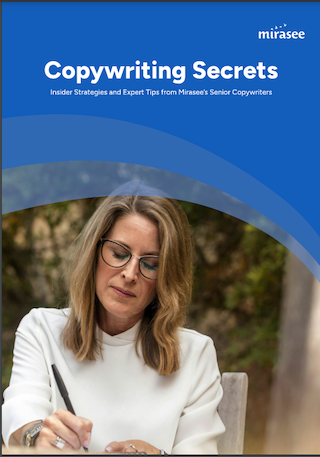The 11 Best Types of Copywriting for Making Money (+ Examples)
Willy Wood
You have a way with words and a solid understanding of business fundamentals, and you’ve been thinking that maybe copywriting might make a good career for you.
Excellent move!
The global copywriting market was valued at $38.1 billion in 2020 and is projected to reach $57.6 billion by 2028. That’s massive!
So yes, copywriting can be a great career.
But “copywriting” covers a lot of territory. There are many different types of copywriting, and most of them pay handsomely.
The good news is you don’t need to master all of them. In fact, you can make a great living just specializing in one or two types.
So, what type of copywriting is right for you?
In this post, we’ll share the pros and cons of the 11 most lucrative types of copywriting you might want to pursue. By the time you’re finished reading, you’ll have a good understanding of your options—and you’ll probably be jazzed to get started!
But before we get into all of that, we need to talk about what copywriting is…
What IS Copywriting?
Let’s start with a straightforward definition that most experts agree on:
Copywriting is the process of writing words intended to persuade readers to take a specific action.
Pretty straightforward, right? But when you start digging, that definition starts getting a little “fuzzy.”
For example:
- The action you’re hoping the reader takes may be immediate (clicking a link in an email, filling out an opt-in form, hitting the Buy button in a sales letter) or it may be a delayed action (reading informational content, like a blog or social post in the present that’s intended to build the brand in the reader’s mind, leading to the reader taking a specific action sometime in the future).
- The copy you’re writing may be a 10-word ad or a 5,000 word long-form sales letter.
- The tone or “brand voice” you write in might be buttoned-up and serious (think financial newsletter) or playful and whimsical (think Christmas toy catalog).
- Your copy might be aimed at persuading a single customer to buy a five-dollar physical product or it might be aimed at getting a multinational corporation to buy a five-figure service package.
Truth is, copywriting is both simple and complicated. No matter what kind of copywriting you’re doing, your goal is to get the reader to do something. Simple.
But the “something” you’re trying to get them to do and the way you go about convincing them to do it can vary significantly.
That’s why we’re going to share with you 11 lucrative types of copywriting, so you can find the types that best fit your personality, writing style, and skillset.
So, are you ready to learn all the ways you can create a high-paying career in copywriting?
Let’s go!
The 11 Best Types of Copywriting
The following 11 types of copywriting cover a lot of territory. We’ll start off with some broad categories of copywriting, then narrow things down to some more specific types as we go.
1. B2B Copywriting
B2B (business to business) copywriters help companies sell their products and services directly to other businesses.
For example…
- A business consulting firm markets its services to other businesses to help them grow.
- A medical equipment company sells its products to hospitals and clinics.
- A food company sells its products to supermarkets.
These are all B2B transactions, and they all need copy written for them as part of their sales efforts.
B2B copywriting differs significantly from B2C (business to consumer) copywriting, which we’ll talk about in just a moment. For one thing, while consumers buy for a wide variety of reasons, the main reason businesses buy products or services generally comes down to one thing—money—either saving it or making more of it.
Take a look at this copy on Convert Kit’s Home page:

Notice that the pitch is from a business (Convert Kit) offering a solution (grow your audience and make more money with our software) to other businesses (in this case, creative entrepreneurs).
Another big difference is that with B2B, there are more people involved in the transaction (meaning more people you need to convince to buy), which leads to a much longer sales cycle.
The great thing about this for a copywriter is that B2B companies need a LOT of copy aimed at a number of audiences within the business they’re trying to sell into, meaning that you can get a great deal of work from a single client, cranking out copy such as white papers, case studies, press releases, ebooks, blog posts, sell sheets, etc.
And oh yeah, B2B companies tend to pay very well for good copywriting.
2. B2C Copywriting
The flipside of B2B copywriting is B2C (business to consumer) copywriting. In B2C, companies sell directly to consumers.
B2C businesses are all around you—brick and mortar businesses such as the supermarket, the coffee shop down the street, and the clothing stores you frequent, as well as online B2C businesses such as any business that has an online store, including the 1,000-pound gorilla of B2C, Amazon.
And again, they all need copy!
Just think of all the kinds of copy B2C companies need:
- Product descriptions in online stores
- Product descriptions and ingredient information on the packaging
- Ads for all of these products on Google, Facebook, etc.
- Sales flyers
- Coupons
- And much more.
For example, from Target’s Home page…
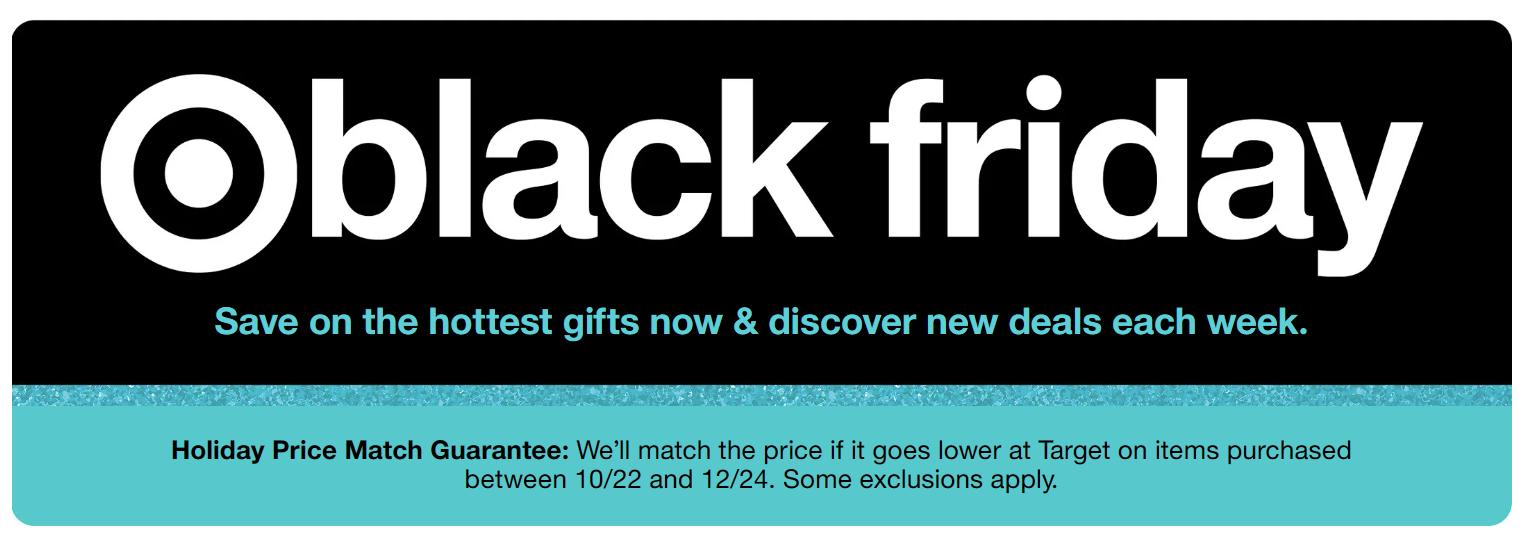
Now, big B2C companies like Walmart and Target hire agencies to do their copywriting, but you can make money writing for smaller B2C companies, even local brick and mortar stores in your area. If you can get your foot in the door with a few good clients, you could be writing (and getting paid for) all of that copy.
3. Direct Response Copywriting
Remember our definition of “copywriting” earlier?
Copywriting is the process of writing words intended to persuade readers to take a specific action.
That’s what we mean by “direct response.” You’re writing copy that attempts to persuade someone to take a direct action immediately. This could be…
- To get them to fill in an opt-in form to download a lead magnet
- To get them to click a link in an email to go to a landing page
- To get a website visitor to click the Contact Me button
- To get someone to comment on a social post
- To get them to sign up for a webinar…
- Or any of a hundred other direct actions.
For example, here’s an email from business guru Marie Forleo, pitching her annual copywriting program, The Copy Cure. Note that she’s pulling out all the stops, including urgency (the doors are closing soon!) to get you to click a link and go to the landing page to sign up and pay.

The other super important aspect of direct response copywriting is that it’s measurable. The company you’re writing for will be able to see, within a matter of days—or even hours—how well the copy is working.
So, there will be one or more metrics that your client will be monitoring to see if your copy is doing the job. And if it is, your client is making money. Which means you’ll be making money because a copywriter who helps the company make a profit is extremely valuable to that company.
So, if you like to write persuasively—and you’re good at it—direct response copywriting may just be your ticket!
4. Brand Copywriting
Just as B2B copywriting and B2C copywriting pretty much cover all the copywriting territory when it comes to clients and the customers they serve, direct response copywriting also has its opposite—brand copywriting.
While direct response copywriting is all about getting an immediate action from the reader, brand copywriting has a different purpose altogether, and a much longer timeline. Brand copywriting focuses on brand awareness, which takes a while to build in a reader’s mind.
A brand awareness ad doesn’t try to get the reader to take any specific action in the present. The ultimate goal is to make the reader think of the company first when they feel the need to purchase a product or service in a market in which the company competes.
When it comes to brand advertising, most people think of big, iconic brands like Coca-Cola, Anheuser Busch, or Apple. While these brands do also use direct response copywriting to sell specific products or when they’re doing a new product launch or a sale, they also spend a huge amount of their budget on brand advertising to stay top of mind with their audience.
For example, this from Starbucks…

But much smaller companies also utilize brand copywriters to try to establish their brands in the minds of their target market. Which is a good thing, because good luck landing a gig with one of the behemoth companies that spend millions on TV advertising.
That’s alright, though, because if you can create branding campaigns and write attention-getting copy that causes an emotional reaction in the reader, some of these smaller companies will definitely give you a shot.
And since this kind of copywriting isn’t judged by immediate response and metrics, you don’t have to focus so much on persuasive language. If you don’t like to write copy that feels like you’re being pushy, brand copywriting just might be the gig for you.
OK, let’s take stock of what we’ve covered to this point. All copywriting can be divided into B2B or B2C copywriting, based on the client you’re writing for and who they’re trying to sell to. All copywriting can also be divided into direct response copywriting or brand copywriting, depending on the goal the client is trying to achieve with the copy.
This gives you four broad areas you might decide to focus on:
- B2B direct response copywriting
- B2B brand copywriting
- B2C direct response copywriting
- B2C brand copywriting
Each of those four categories is huge and there’s a ton of work to be had in any of them.
So let’s get a little more specific and look at some of the areas you could decide to specialize in within any of those four broader areas…
5. Web Copywriting
Web copywriting focuses on writing static pages for websites, such as the Home page, the About page, Services or Product pages, etc. As a web copywriter, you can write full websites, revise existing pages, or write new, additional pages for the business to add to their site.
If you decide to become a web copywriter, you will also need to be somewhat of an expert on SEO (search engine optimization) because it doesn’t do a company any good to have a well-written site if it doesn’t rank well in search.
The good news is that, if you can combine the skill of writing web pages with solid SEO knowledge, you’ll never be short of business. After all, pretty much every business needs a website:
- E-commerce businesses are looking to turn website traffic into immediate product sales.
- SaaS businesses are usually looking to get sign-ups for a free trial of their software.
- Local services businesses are usually trying to get the web visitor to give them a call.
- And B2B services businesses, who typically sell high-ticket services, are usually looking to get the visitor to opt-in for an information product lead magnet so the company can then follow up and begin nurturing them.
If you can help businesses get more traffic to their sites (that’s the SEO part) and write engaging content that converts that traffic once they get there, you’ll be in high demand.What do we mean by “engaging content”? Check out this bit of copy from the Dollar Shave Club site. This is representative of the fun, cheeky tone the site utilizes for their copy:
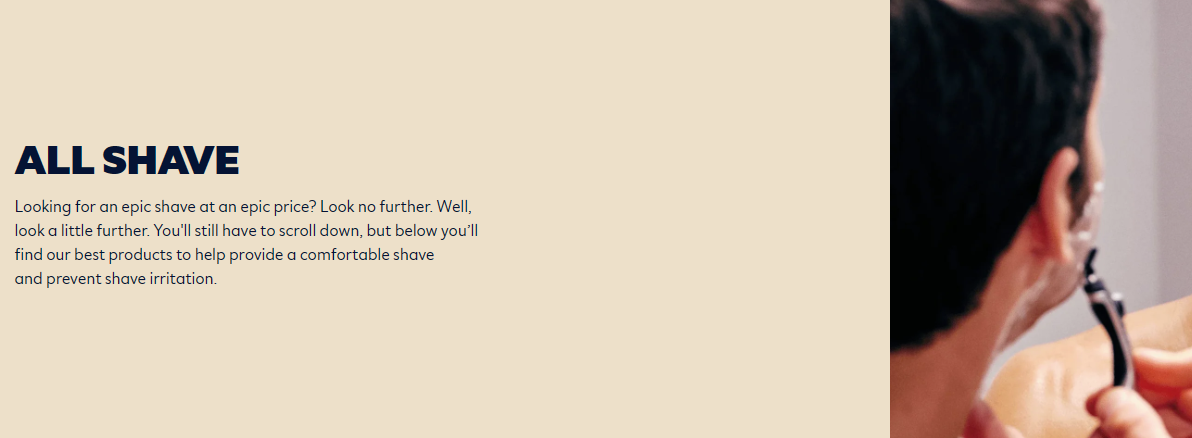
“Looking for an epic shave at an epic price? Look no further. Well, look a little further. You’ll still have to scroll down, but below you’ll find our best products to help provide a comfortable shave and prevent irritation.”
And not only can you make a good living writing the web pages themselves, but a good web copywriter often does a variety of ancillary copywriting jobs in addition to writing a site’s pages.
- You might write chatbot scripts to enhance the site’s user experience.
- You might land a recurring gig writing the site’s blog posts.
- You might write social media posts to drive traffic to the website.
- You might write ads for paid advertising to drive traffic to specific offers on the site.
You get your foot in the door with the main website writing, then offer to do one or more of these other copywriting jobs for the company.
6. SEO Copywriting
SEO copywriting is writing intended to get a blog post, article, or web page to rank highly on Google or other search engines in order to get more traffic to a company’s content.
We mentioned SEO in the previous section in relation to web copywriting, and that aspect of it is very important. But if you decide to specialize in SEO, you’ll also be writing content like blog posts and articles for your client and incorporating specific keywords strategically into that content in order to get it to rank highly for those keywords. You may also be asked to take posts that aren’t ranking well and revise them to get them to rise in the search results.
For example, if you type the keyword “electric bicycles” into Google, you’ll see a blog post from Wired.com show up at the top of the search results:

That’s no accident. The writer intentionally used “electric bikes” in the blog title and “electric bicycles” in the first sentence of the post, then followed up with a meaty, informative blog post–the kind the search engines love.
Sometimes your client will give you the keyword(s) they want to rank for, and sometimes they’ll ask you to do the keyword research before utilizing the best keywords you find to write the content. So, you’ll also need to be proficient with one or more keyword research tools.
SEO is hugely important for most businesses. Sure, advertising is the fastest way to get customers, but it also costs the business every time they place an ad. If the ads don’t convert well, the business may end up paying more for the ad than they make from it.
SEO, on the other hand, is the “long game.” It takes a while to build traffic from your SEO efforts, but if you do a good job with it, once the traffic starts rolling in, it often continues for months without any extra investment on the business’s part (they love that!).
If you show your worth as an SEO copywriter, you’ll likely score multiple recurring writing gigs, writing regular SEO-optimized articles or blog content on a retainer basis. So, not only does SEO copywriting pay well, it can be one of the most stable types of copywriting for recurring revenue.
7. Social Media Copywriting
Another area where you can specialize in copywriting is social media. The social media industry is huge and steadily growing, with new platforms arising every few years. And both B2B and B2C companies are jumping on the opportunity to engage their ideal prospects—often on more than one platform.
There are a variety of purposes for which companies use social media. They may be wanting to…
- Create brand awareness
- Generate engagement and conversation
- Get someone to like, follow, and/or share a post or page
- Direct people to other content, like a company’s blog posts
- Direct people to a sales page
One challenge for social media copywriters is that, due to the nature of social media platforms, you need to create copy that gets the job done in a small number of words and/or images. Your copy will need to be short and conversational, and it must achieve the goal of the post succinctly.
In the following LinkedIn post, Gary Vaynerchuk posts a thought-provoking statement and a video to drive discussion. You can see that, at the time of this writing, the post had 45 comments and 53 reposts. Now, Gary Vaynerchuk likely writes all of his own social posts, but many companies don’t have the time or expertise to crank out social content every day, which means they need to hire a copywriter to do it.
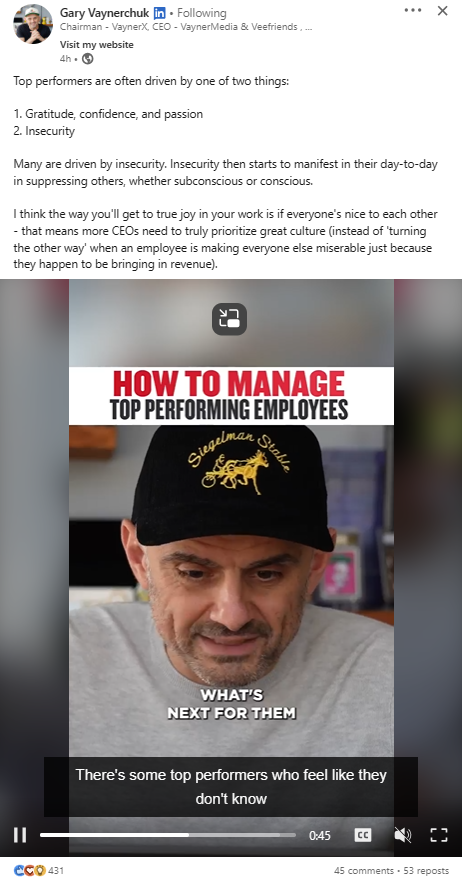
Eye-catching graphics are also important on certain platforms, especially Instagram, Tik Tok, and Pinterest, while other platforms, like YouTube, are all about video. This means that you’ll need to have a good eye for visuals as well as being a wordsmith.
You can decide to specialize in one or two platforms or become proficient in many. Just realize that every platform requires a different approach.
If you develop proficiency in social media copywriting, you can make a substantial amount of money. Copywriters can earn over $1,000 per client per month in this field (and experienced writers can earn far more), and if you get your clients the results they’re looking for, they’ll often hire you on a retainer basis to create a certain amount of content per month. This means that you can make a very stable, recurring income from your social media copywriting efforts.
8. Ad Copywriting
As we mentioned previously, the goal of paid advertising is to drive an immediate action—to sign up for your lead magnet, download a white paper, buy your product or service, etc.
Companies pay money to get their ads in front of their ideal customers and they find out almost immediately whether those ads worked for the desired purpose or not—making paid advertising the king of direct marketing genres.
Ads are generally short-form copy, meaning there’s a premium placed on getting every word just right. And to do that, you need to know the company’s target audience intimately, know what their problems are, and know how the company’s product or service solves those problems.
For example, here’s a sponsored Google ad for Lululemon yoga pants. The copy is very short, but for a yoga practitioner who prizes comfort over all else, the line “Yoga Pants So Buttery Soft and Stretchy You’ll Forget They’re On” is definitely a selling point.

If you can demonstrate that your copy can make your client more money than it costs them to run the ads, you’ll be in high demand. Even better, ads have a shelf-life. An ad might work for a few months or longer, but eventually, it will need to be reworked as it loses its effectiveness. Plus, companies are always creating new offers that they need to get in front of their audience. This means repeat work for you.
There’s a great deal of high-paying work available for good ad copywriters. That said, most companies, especially larger ones, don’t look for freelance copywriters to write their ads. They almost always seek out ad agencies for this kind of work. So, if you’re interested in becoming an ad copywriter, you might want to look for a job with an agency or with the client company itself as a staff copywriter.
9. Email Copywriting
Email copywriting is writing emails to be sent out to a business’s prospects, customers, and clients.
The main three types of emails businesses hire copywriters for are:
- Welcome sequences—a series of emails, usually between three and seven, that welcome new opt-ins, deliver any lead magnets or other materials the person signed up for, and begin building a relationship with them.
- Nurture emails—the regular (usually several times a week up to daily) emails a company sends out to deliver value and continue building relationships with their list.
- Sales sequences—a series of emails sent out when a business is launching a new product or service, an event, or just advertising a sale.
The welcome sequences and nurture emails are designed to grow a relationship with opt-ins, deliver ongoing valuable information, and familiarize them with the company’s offerings. All of this sets up the sales sequences, which is where the company capitalizes on the relationships they’ve built with their list.
The email below is one of the emails in a sales sequence from copywriter Laura Belgray, who co-created The Copy Cure copywriting course we mentioned earlier with Marie Forleo:
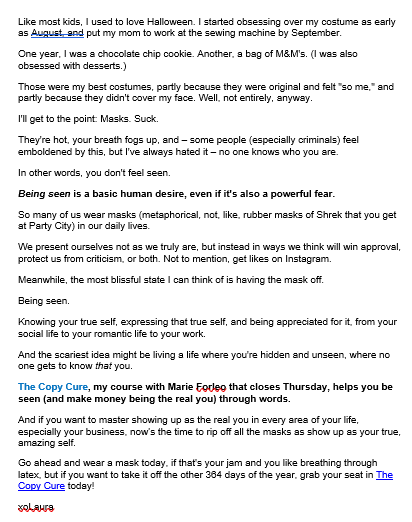
Email marketing provides the best ROI to online businesses of anything else they do. This is because their lists, if they’ve been properly nurtured, are primed to buy whenever the company puts out an offer.
And because email has such a great ROI for businesses, they’re more than happy to pay a good email copywriter handsomely to write all the emails needed to keep this “money machine” cranking out the dolla’ dolla’ bills. If you can get in with several clients needing emails every week, you’re set!
10. Technical Copywriting
Technical copywriting is writing copy for the science and technology fields. As such, it’s quite challenging, requiring that you:
- Understand the concepts that the writing needs to convey (meaning that it’s quite helpful for you to have a scientific or technical background, yourself) and
- That you’re able to take the complex material and break it down so that the lay person can understand it.
One key to being able to do this is to steer clear of technical language and industry jargon while still getting across the meaning of the material.
If you decide to go into technical copywriting, you’ll likely be asked to write materials such as:
- How-to manuals
- Reference guides
- Case studies
- White papers
- Procedure manuals
- And much more
For example, Amazon Web Services has produced a number of white papers to teach people how to best use their services. Here’s one:

Technical writing is always in demand. On the other hand, the supply of copywriters who can handle the challenges of writing good technical copy is always lower.
And you know what high demand coupled with low supply means, right? It means that businesses in the tech sector will pay really well for someone who can do the job.
So, if you have a STEM background and can produce clear copy, you shouldn’t have any trouble finding all the work you could want.
11. Public Relations Copywriting
Businesses often struggle to get noticed. And if they can’t build a recognizable brand, it’s difficult to compete with others in their field.
This is why they need to take advantage of public relations (PR) opportunities every chance they get.
If a company has anything going on that’s newsworthy—a new product launch, a special event, a change in leadership, or any other kind of breaking news—they’re smart to get a press release out and distribute it widely to get as many eyeballs on the news as possible.
And that’s where a PR copywriter comes into the picture.
Sure, many companies have someone on staff who’s not really a copywriter dash off something for a press release, but those companies are missing a great opportunity. Because a good PR copywriter who knows how to start a press release with an engaging hook and present the news with a bit of flair can get the company’s news to break through and rise to the attention of people in their market.
By an “engaging hook,” we mean something along the lines of what Six Flags did with this recent press release (headline and first paragraph shown):

If this is something that interests you, there’s plenty of work to go around. After all, every company is trying to get noticed!
Identify Your Favorite Types of Copywriting and Make Your Mark!
When most people think about “copywriting,” they have a limited understanding of what it is. In fact, there’s not really such a thing as generic “copywriting” as a career. It’s really more of an umbrella term that covers a wide variety of possible writing careers.
In this post, we’ve discussed 11 different types of copywriting, and each one of these types offers you a pathway to a rewarding—and highly lucrative—career. That’s because businesses need copy, more today than ever before, and the demand is only growing. As long as there are products and services to be sold, businesses will need copywriters.
So, the only question left is, which types of copywriting are you going to focus on? Pick one or two types to start with and start earning a solid living. And then, if you’d like to expand from there, explore another copywriting type and grow your skill set.
Good luck!
Elevate Your Copywriting Game!
Discover winning strategies and insider tips for writing words that sell - from Mirasee’s very own expert copywriting team!